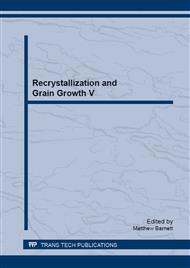[1]
H. E. Vatne, T. Furu, R. Ørsund, and E. Nes, Modelling recrystallization after hot deformation of aluminium. Acta materialia 44 (1996) 4463-4473.
DOI: 10.1016/1359-6454(96)00078-x
Google Scholar
[2]
J.A. Sæter, B. Forbord, H.E. Vatne, and E. Nes, Modelling recovery and recrystallization, applied to back-annealing of aluminium sheet alloys. Proceedings 6th International Conference on Aluminum Alloys, ICAA-6 eds. T. Sato et al., JILM, Japan, 1998, pp.113-126.
Google Scholar
[3]
O. Engler, L. Löchte, J. Hirsch, Through-process simulation of texture and properties during the thermomechanical processing of aluminium sheets, Acta Materialia 55 (2007) 5449–5463.
DOI: 10.1016/j.actamat.2007.06.010
Google Scholar
[4]
K. Marthinsen, J. Friis, B. Holmedal, I. Skauvik, and T. Furu, Modelling the recrystallization behaviour during industrial processing of aluminium alloys. Materials Science Forum Vols. 715-716 (2012) 543-548.
DOI: 10.4028/www.scientific.net/msf.715-716.543
Google Scholar
[5]
J. W. Dunlop, Y. J. M. Brechet, L. Legras, and H. S. Zurob, Modelling isothermal and non-isothermal recrystallisation kinetics: Application to zircaloy-4. Journal of Nuclear Materials 366 (2007) 178-186.
DOI: 10.1016/j.jnucmat.2006.12.074
Google Scholar
[6]
W. Schneider, A. Koeppl, and J. Berger, Non-isothermal crystallization of polymers. System of rate equations, Int. Polym. Proc. 2 (1998) 151-154.
Google Scholar
[7]
H. S. Zurob, Y. Brechet, and J. Dunlop, Quantitative criterion for recrystallization nucleation in single-phase alloys: Prediction of critical strains and incubation times. Acta Materialia 54 (2006) 3983-3990.
DOI: 10.1016/j.actamat.2006.04.028
Google Scholar
[8]
J.W. Christian, The Theory of Transformation in Metals and Alloys, Pergamon, Oxford, 2002.
Google Scholar
[9]
F. Humphreys, M. Hatherly, Recrystallization and Related Annealing Phenomena, Pergamon, Oxford, 1995.
Google Scholar
[10]
E.A. Holm, M.A. Miodownik, A.D. Rollett, On abnormal subgrain growth and the origin of Acta Materialia 51 (2003) 2701–2716.
DOI: 10.1016/s1359-6454(03)00079-x
Google Scholar
[11]
S. Bunkholt, K. Marthinsen, E. Nes, Recovery Kinetics in High Purity and Commercial Purity Aluminium Alloys, ibid.
DOI: 10.4028/www.scientific.net/msf.753.235
Google Scholar
[12]
F. Humphreys, Nucleation in recrystallization, in: B. Bacroix, J. Driver, R. Le Gall, C. Maurice, R. Penelle, H. Réglé (Eds.), Recrystallization and Grain Growth, vol. 1, Trans Tech., Annecy, 2004, p.629.
Google Scholar


